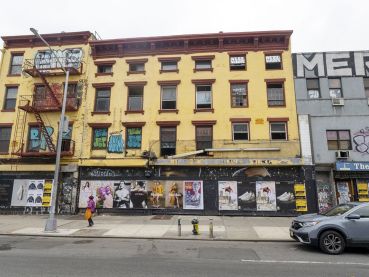The Year in Real Estate: From GSA to Hurricane Sandy, A Look Back at 2012
By Billy Gray December 18, 2012 7:00 am
reprintsJust when New York’s traditional geographic dividing lines were beginning to seem quaint, Hurricane Sandy made landfall and brought them back to light.
Downtown, which over the years had become harder and harder to distinguish from uptown, was plunged into darkness, sending the relatively young and vaguely creative well above 14th Street nosebleed territory in search of power. Only the Brooklyn side of the Williamsburg Bridge stayed illuminated, a stark metaphor for the borough’s slow transformation into a contender.
But in commercial real estate, boundaries continued to disappear. In January, Condé Nast expanded its 1.05-million-square-foot lease at 1 World Trade Center by 138,773 square feet, helping lower Manhattan shed its stodgy finance-centric reputation and prompting slight panic among the owners of Midtown media canteens like Michael’s.The French advertising giant Havas Group inked a deal in March for 226,000 square feet at 200 Hudson Street, partly thanks to the growing tech presence in Tribeca and Soho’s western fringes. In July, the New York Genome Center and Amerigroup signed 171,000- and 165,029-square-foot leases, prominent instances of the medical and health care boom in Manhattan. (Cornell’s $2 billion graduate science campus will be a capstone on this progress when it opens on Roosevelt Island.)
Jay-Z christened the Barclays Center in September when he kicked off an eight-night residency at the arena, a homecoming for the Brooklyn-born rapper and a victory for Forest City Ratner Companies, which had steered the contentious Atlantic Yards development project through years of local opposition. Next up for Downtown Brooklyn is more than eight million square feet of office, residential and retail space, some of it modular. But for now, Barclays Center is nipping at Madison Square Garden’s heels in the race to be New York’s prime stage.
The Garden has to pick up its game, but its backyard is in the midst of a transformation that should ease the aging process. Related Companies founder Stephen Ross and Mayor Michael Bloomberg were on hand to see Hudson Yards break ground on December 4. When the project’s South Tower opens, hopefully in 2015, Coach will be the anchor tenant, with 750,000 square feet in the 47-story, 1.7-million-square-foot building.
Three years before the South Tower’s completion, 34th Street is heating up: asking rents in Herald Square surged by 30 percent in the third quarter compared with 2011, with Sam Ash and Bon Bébé signing significant leases.
Another western gold rush continued further uptown as the Columbus Avenue corridor continued to sizzle. In March, the street’s Business Improvement District reached 100 percent occupancy for all the shops in its zone, even as real estate firms, business owners and community board members clashed over zoning proposals intended to limit storefront sizes and keep big-box chains at bay.
A doozy of a development quarrel was set up this fall when the Bloomberg administration proposed substantial changes to the zoning of Midtown East, a neighborhood few people saw as underutilized or in need of any more density. But, according to a Department of City Planning report, the neighborhood’s famous skyline is in serious need of a nip and tuck.
The centerpiece of the DCP’s proposal is an increase in maximum allowable building density by as much as 60 percent in certain portions of the 78-block project zone. Some urban planners and conservationists instantly objected, saying the changes would compound overcrowding, dwarf beloved buildings like the Chrysler Building or lead to the demolition of non-landmarked classics including the Yale Club.
In its East Midtown Study, the DCP reports that 80 percent of the neighborhood’s buildings are over 50 years old, with the average build year just predating America’s entry into World War II. A source familiar with the study told The Commercial Observer that many planners had neglected to note Midtown East’s encroaching decrepitude while they were preoccupied with creating new business districts like Hudson Yards. While this redevelopment is still early in the proposal phase, the fate of the country’s premier business district will remain a topic of conversation.
A subtler development in Midtown concerned Fifth Avenue, where the invisible 49th Street borderline separating classy (above, through 59th Street) and trashy (below, through 42nd Street) became more porous. Swedish retailer H&M signed for 57,000 square feet at 598 Fifth Avenue (at 48th Street), its biggest store in the world. Aritzia, Joe Fresh, Ted Baker, Tommy Bahama and an expanded Lacoste are among the other retailers lending lower Fifth a hand as it gains some ground on its ritzy upper half.
In more troubling news, Sandy devastated broad, mostly residential swaths of Queens, Brooklyn and Staten Island. Lower Manhattan also suffered—1 and 4 New York Plaza were two of the hardest-hit buildings. But in a testament to New York tenacity, the revitalization of Pier 17 will proceed even after the South Street Seaport sustained major damages.
Lower Manhattan is no stranger to devastation, and this year dramatic progress was made at the site of a previous tragedy. The General Services Administration inked a 270,000-square-foot lease—the year’s biggest—at 1 World Trade Center, vaulting it past 50 percent occupancy.
More majestically, the building finally made its mark on the skyline, soaring to become a steel and concrete lodestar to New Yorkers across the five boroughs.


